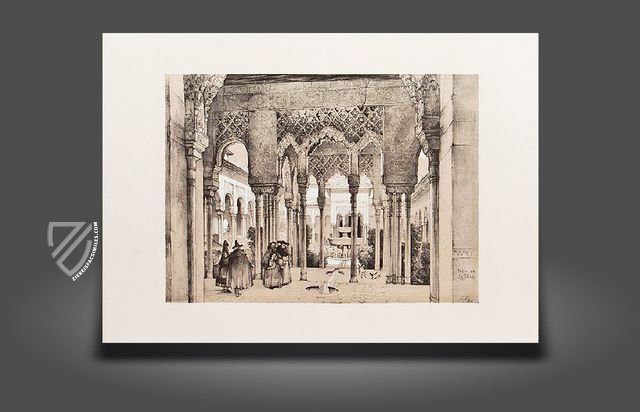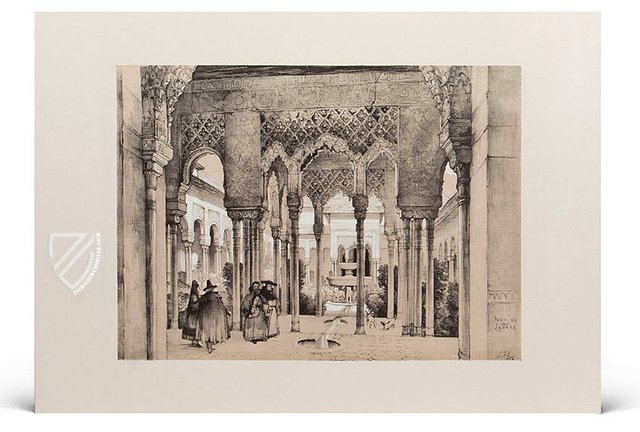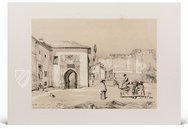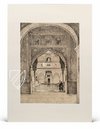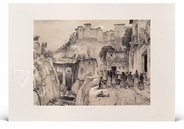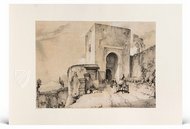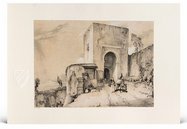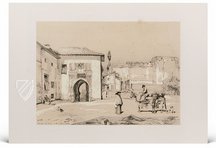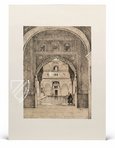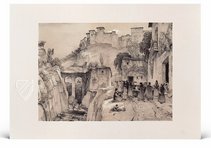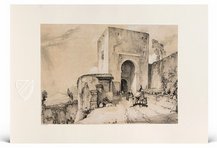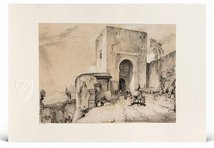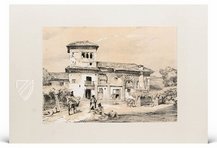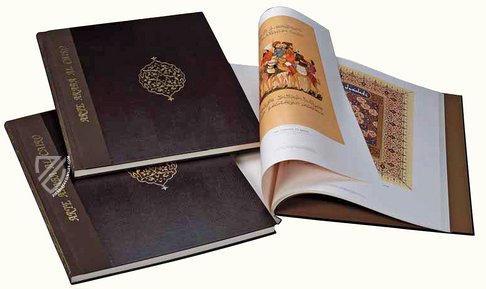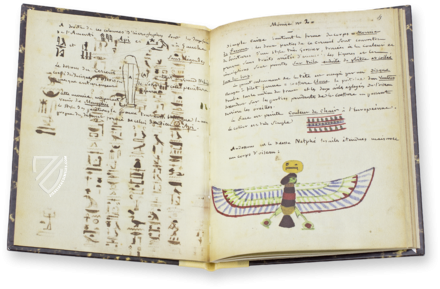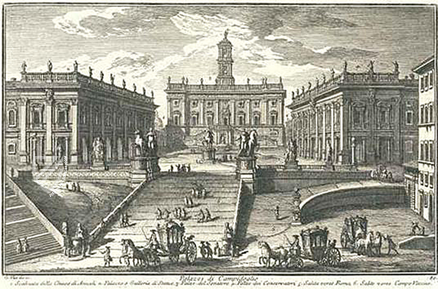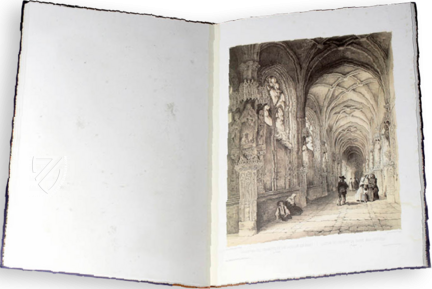Prints of the Alhambra
(under 1,000€)
The famous Alhambra in Spanish Grenada enchants people to this day with its exotic history and marvelous architecture. Already in the 19th century, the Alhambra encouraged swarms of tourists and the dreams of those who wished they could travel. One man who significantly encouraged this yearning for the Alhambra was the British painter John Frederick, who can be considered a true 19th century globetrotter and can be ascribed to the Orientalist movement. With his album Sketches and Drawings of the Alhambra, published in 1833 and consisting of numerous lithographs of his paintings, he created a bestseller. Six sheets of this exotic visual world offer an inside view of the Alhambra from a 19th century perspective.
Prints of the Alhambra
The famous Alhambra in Spanish Grenada enchants people to this day with its exotic history and marvelous architecture. Already in the 19th century, the Alhambra encouraged swarms of tourists and the dreams of those who wished they could travel. One man who significantly encouraged this yearning for the Alhambra was the British painter John Frederick, who can be considered a true 19th century globetrotter and can be ascribed to the Orientalist movement. With his album Sketches and Drawings of the Alhambra, published in 1833 and consisting of numerous lithographs of his paintings, he created a bestseller. Six sheets of this exotic visual world offer an inside view of the Alhambra from a 19th century perspective.
A British Globetrotter
John Frederick Lewis (1805–1876) is known as an important British painter and artist of the 19th century. His works are stored today in the Tate and other important British collections. Lewis undertook numerous additional journeys and extended stays abroad. The artist spent ten years in Egypt, inter alia. However, he also found artistic inspiration for his artistic creativity in Italy, Spain, and other parts of the world. With his pictures of the exotic and foreign worlds that he encountered on his travels, Lewis was close to the Orientalist movement.
The Sketches of the Alhambra
The 19th century shaped the romantic image of many corners of the Earth. The enthusiasm for exotic and foreign worlds finds particular expression in Romanticism, and here in Orientalism in particular. These tendencies simultaneously fostered the beginning of tourism and British interest in Spain awoke in the 1830’s. John Frederick Lewis undertook a Spanish sojourn in the years 1832-4. He prepared his impressions of this trip in paintings, which in turn served as a templates for his lithography portfolio with the original title of Sketches and Drawings of the Alhambra, made during a Residence in Granada, in the Years 1833-4. Drawn on Stone by J.D. Harding, R.J. Lane, A.R.A, W. Gauci & John F. Lewis.
The Alhambra in Artful Lithographs
Six sheets from this portfolio give an inside look into the effect that this work had in Great Britain. The Alhambra with the Moorish architecture of the fortress in the hills above Grenada, the exuberant, artful Mozarabic ornamentation is still impressive today and sets the mood of this place: the lithographs show both interior views as well as depictions of the city on the rocks. An impressive gate or interior courtyards with idyllic water fountains adorn another page. The scenes are each furnished with detailed and tender decorative figures, respectively. The album gives a living image of the Alhambra in the 19th century. The charm of this location, which continues to attract countless tourists to Grenada today, is made clear in these magnificent works of art!
Codicology
- Alternative Titles
- Grabados de la Alhambra
Zeichnungen der Alhambra - Date
- 19th century
- Epochs
- Style
- Genre
- Artist / School
- John Frederick Lewis (1805–1876) (painter)
Prints of the Alhambra
View of the Alhambra
Originally constructed as a small fortress in the year 899, the Alhambra was expanded into a grand citadel in the mid-13th century and then converted into a royal palace in the 14th century. After falling to the Spaniards in 1492, it became the royal court of Ferdinand and Isabella, the place where the voyage of Christopher Columbus was commissioned, and the site for an imperial palace built by Holy Roman Emperor Charles V. Its formidable defenses are depicted here from one of the towns below.
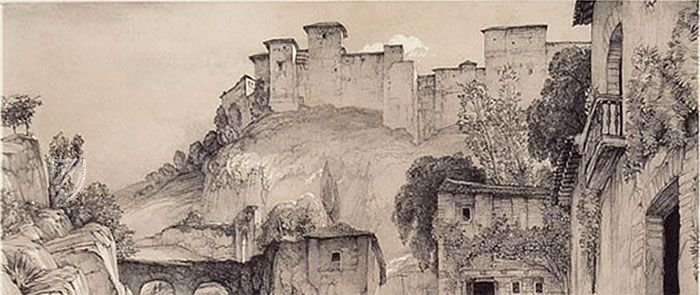
Prints of the Alhambra
Patio de los Leones
The divine Court of the Lions lies as the heart of the Alhambra, Granada’s famous Moorish citadel consisting of palaces, gardens, and fortifications, which was constructed between 1362 and 1391 at the behest of Sultan Muhammed V. It is one of Spain’s greatest architectural monuments, a UNESCO World Heritage Site, beloved tourist attraction, and has inspired artists for centuries.
Designed as an architectural allegory for Paradise, the gardens, water features, and columns form conceptual unity, with the irregularly spaced columns representing the palm trees surrounding an oasis. Wealthy Europeans making a grand tour are pictured strolling through this idyllic scene, and in the background the famous 11th century Lion Fountain can be seen.
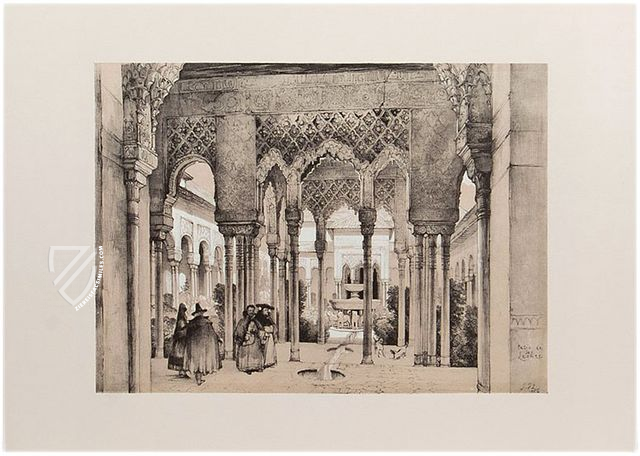
#1 Grabados de la Alhambra
(under 1,000€)
- Treatises / Secular Books
- Apocalypses / Beatus
- Astronomy / Astrology
- Bestiaries
- Bibles / Gospels
- Chronicles / History / Law
- Geography / Maps
- Saints' Lives
- Islam / Oriental
- Judaism / Hebrew
- Single Leaf Collections
- Leonardo da Vinci
- Literature / Poetry
- Liturgical Manuscripts
- Medicine / Botany / Alchemy
- Music
- Mythology / Prophecies
- Psalters
- Other Religious Books
- Games / Hunting
- Private Devotion Books
- Other Genres
- Afghanistan
- Armenia
- Austria
- Belgium
- Belize
- Bosnia and Herzegovina
- China
- Colombia
- Costa Rica
- Croatia
- Cyprus
- Czech Republic
- Denmark
- Egypt
- El Salvador
- Ethiopia
- France
- Germany
- Greece
- Guatemala
- Honduras
- Hungary
- India
- Iran
- Iraq
- Israel
- Italy
- Japan
- Jordan
- Kazakhstan
- Kyrgyzstan
- Lebanon
- Liechtenstein
- Luxembourg
- Mexico
- Morocco
- Netherlands
- Palestine
- Panama
- Peru
- Poland
- Portugal
- Romania
- Russia
- Serbia
- Spain
- Sri Lanka
- Sweden
- Switzerland
- Syria
- Tajikistan
- Turkey
- Turkmenistan
- Ukraine
- United Kingdom
- United States
- Uzbekistan
- Vatican City
- A. Oosthoek, van Holkema & Warendorf
- Aboca Museum
- Ajuntament de Valencia
- Akademie Verlag
- Akademische Druck- u. Verlagsanstalt (ADEVA)
- Aldo Ausilio Editore - Bottega d’Erasmo
- Alecto Historical Editions
- Alkuin Verlag
- Almqvist & Wiksell
- Amilcare Pizzi
- Andreas & Andreas Verlagsbuchhandlung
- Archa 90
- Archiv Verlag
- Archivi Edizioni
- Arnold Verlag
- ARS
- Ars Magna
- ArtCodex
- AyN Ediciones
- Azimuth Editions
- Badenia Verlag
- Bärenreiter-Verlag
- Belser Verlag
- Belser Verlag / WK Wertkontor
- Benziger Verlag
- Bernardinum Wydawnictwo
- BiblioGemma
- Biblioteca Apostolica Vaticana (Vaticanstadt, Vaticanstadt)
- Bibliotheca Palatina Faksimile Verlag
- Bibliotheca Rara
- Boydell & Brewer
- Bramante Edizioni
- Bredius Genootschap
- Brepols Publishers
- British Library
- C. Weckesser
- Caixa Catalunya
- Canesi
- CAPSA, Ars Scriptoria
- Caratzas Brothers, Publishers
- Carus Verlag
- Casamassima Libri
- Centrum Cartographie Verlag GmbH
- Chavane Verlag
- Christian Brandstätter Verlag
- Circulo Cientifico
- Club Bibliófilo Versol
- Club du Livre
- CM Editores
- Collegium Graphicum
- Collezione Apocrifa Da Vinci
- Comissão Nacional para as Comemorações dos Descobrimentos Portugueses
- Coron Verlag
- Corvina
- CTHS
- D. S. Brewer
- Damon
- De Agostini/UTET
- De Nederlandsche Boekhandel
- De Schutter
- Deuschle & Stemmle
- Deutscher Verlag für Kunstwissenschaft
- DIAMM
- Droz
- E. Schreiber Graphische Kunstanstalten
- Ediciones Boreal
- Ediciones Grial
- Ediclube
- Edições Inapa
- Edilan
- Editalia
- Edition Deuschle
- Edition Georg Popp
- Edition Leipzig
- Edition Libri Illustri
- Editiones Reales Sitios S. L.
- Éditions de l'Oiseau Lyre
- Editions Medicina Rara
- Editorial Casariego
- Editorial Mintzoa
- Editrice Antenore
- Editrice Velar
- Edizioni Edison
- Egeria, S.L.
- Eikon Editores
- Electa
- Emery Walker Limited
- Enciclopèdia Catalana
- Eos-Verlag
- Ephesus Publishing
- Ernst Battenberg
- Eugrammia Press
- Extraordinary Editions
- Fackelverlag
- Facsimila Art & Edition
- Facsimile Editions Ltd.
- Facsimilia Art & Edition Ebert KG
- Faksimile Verlag
- Feuermann Verlag
- Folger Shakespeare Library
- Franco Cosimo Panini Editore
- Friedrich Wittig Verlag
- Fundación Hullera Vasco-Leonesa
- G. Braziller
- Gabriele Mazzotta Editore
- Gebr. Mann Verlag
- Gesellschaft für graphische Industrie
- Getty Research Institute
- Giovanni Domenico de Rossi
- Giunti Editore
- Graffiti
- Grafica European Center of Fine Arts
- Guido Pressler
- Guillermo Blazquez
- Gustav Kiepenheuer
- H. N. Abrams
- Harrassowitz
- Harvard University Press
- Helikon
- Hendrickson Publishers
- Henning Oppermann
- Herder Verlag
- Hes & De Graaf Publishers
- Hoepli
- Holbein-Verlag
- Houghton Library
- Hugo Schmidt Verlag
- Idion Verlag
- Il Bulino, edizioni d'arte
- ILte
- Imago
- Insel Verlag
- Insel-Verlag Anton Kippenberger
- Instituto de Estudios Altoaragoneses
- Instituto Nacional de Antropología e Historia
- Introligatornia Budnik Jerzy
- Istituto dell'Enciclopedia Italiana - Treccani
- Istituto Ellenico di Studi Bizantini e Postbizantini
- Istituto Geografico De Agostini
- Istituto Poligrafico e Zecca dello Stato
- Italarte Art Establishments
- Jan Thorbecke Verlag
- Johnson Reprint Corporation
- Josef Stocker
- Josef Stocker-Schmid
- Jugoslavija
- Karl W. Hiersemann
- Kasper Straube
- Kaydeda Ediciones
- Kindler Verlag / Coron Verlag
- Kodansha International Ltd.
- Konrad Kölbl Verlag
- Kurt Wolff Verlag
- La Liberia dello Stato
- La Linea Editrice
- La Meta Editore
- Lambert Schneider
- Landeskreditbank Baden-Württemberg
- Leo S. Olschki
- Les Incunables
- Liber Artis
- Library of Congress
- Libreria Musicale Italiana
- Lichtdruck
- Lito Immagine Editore
- Lumen Artis
- Lund Humphries
- M. Moleiro Editor
- Maison des Sciences de l'homme et de la société de Poitiers
- Manuscriptum
- Martinus Nijhoff
- Maruzen-Yushodo Co. Ltd.
- MASA
- Massada Publishers
- McGraw-Hill
- Metropolitan Museum of Art
- Militos
- Millennium Liber
- Müller & Schindler
- Nahar - Stavit
- Nahar and Steimatzky
- National Library of Wales
- Neri Pozza
- Nova Charta
- Oceanum Verlag
- Odeon
- Orbis Mediaevalis
- Orbis Pictus
- Österreichische Staatsdruckerei
- Oxford University Press
- Pageant Books
- Parzellers Buchverlag
- Patrimonio Ediciones
- Pattloch Verlag
- PIAF
- Pieper Verlag
- Plon-Nourrit et cie
- Poligrafiche Bolis
- Presses Universitaires de Strasbourg
- Prestel Verlag
- Princeton University Press
- Prisma Verlag
- Priuli & Verlucca, editori
- Pro Sport Verlag
- Propyläen Verlag
- Pytheas Books
- Quaternio Verlag Luzern
- Reales Sitios
- Recht-Verlag
- Reichert Verlag
- Reichsdruckerei
- Reprint Verlag
- Riehn & Reusch
- Roberto Vattori Editore
- Rosenkilde and Bagger
- Roxburghe Club
- Salerno Editrice
- Saltellus Press
- Sandoz
- Sarajevo Svjetlost
- Schöck ArtPrint Kft.
- Schulsinger Brothers
- Scolar Press
- Scrinium
- Scripta Maneant
- Scriptorium
- Shazar
- Siloé, arte y bibliofilia
- SISMEL - Edizioni del Galluzzo
- Sociedad Mexicana de Antropología
- Société des Bibliophiles & Iconophiles de Belgique
- Soncin Publishing
- Sorli Ediciones
- Stainer and Bell
- Studer
- Styria Verlag
- Sumptibus Pragopress
- Szegedi Tudomànyegyetem
- Taberna Libraria
- Tarshish Books
- Taschen
- Tempus Libri
- Testimonio Compañía Editorial
- Thames and Hudson
- The Clear Vue Publishing Partnership Limited
- The Facsimile Codex
- The Folio Society
- The Marquess of Normanby
- The Richard III and Yorkist History Trust
- Tip.Le.Co
- TouchArt
- TREC Publishing House
- TRI Publishing Co.
- Trident Editore
- Tuliba Collection
- Typis Regiae Officinae Polygraphicae
- Union Verlag Berlin
- Universidad de Granada
- University of California Press
- University of Chicago Press
- Urs Graf
- Vallecchi
- Van Wijnen
- VCH, Acta Humaniora
- VDI Verlag
- VEB Deutscher Verlag für Musik
- Verlag Anton Pustet / Andreas Verlag
- Verlag Bibliophile Drucke Josef Stocker
- Verlag der Münchner Drucke
- Verlag für Regionalgeschichte
- Verlag Styria
- Vicent Garcia Editores
- W. Turnowski Ltd.
- W. Turnowsky
- Waanders Printers
- Wiener Mechitharisten-Congregation (Wien, Österreich)
- Wissenschaftliche Buchgesellschaft
- Wissenschaftliche Verlagsgesellschaft
- Wydawnictwo Dolnoslaskie
- Xuntanza Editorial
- Zakład Narodowy
- Zollikofer AG

